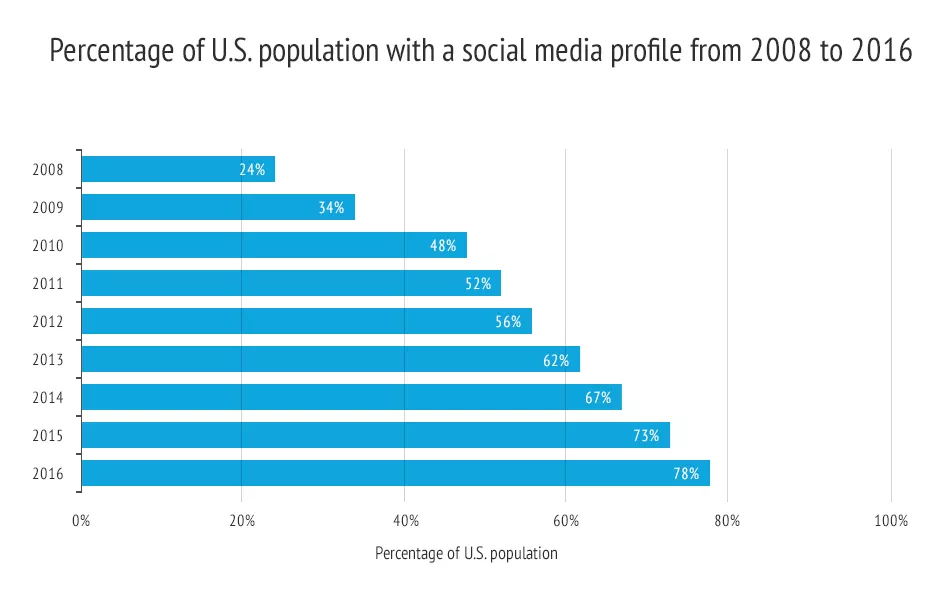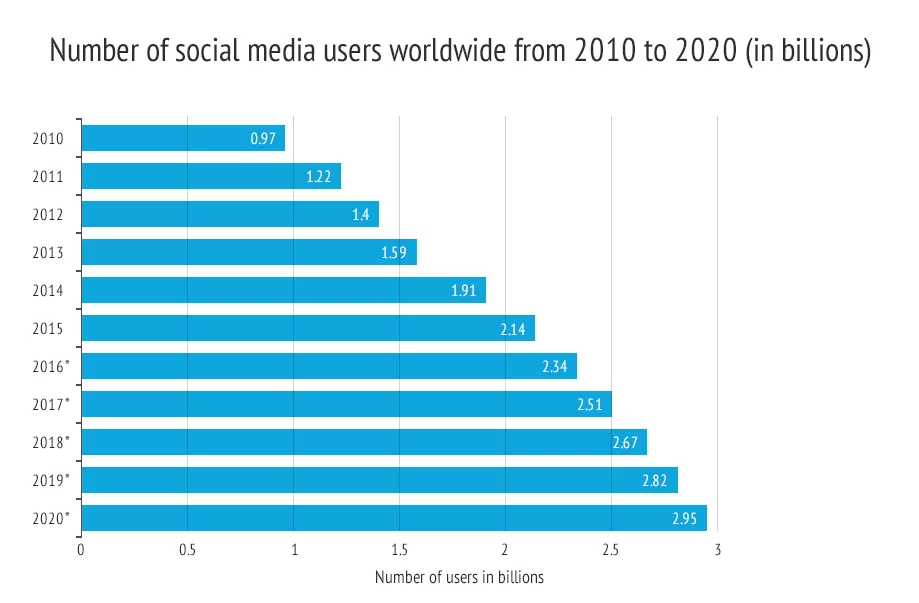Social Media PPC: new marketing channel vs traditional PPC and SMM
When you think about digital marketing tools for business promotion, you definitely come to pay-per-click advertising. This is because PPC represents the basis of Internet marketing, together with SEO and now SMM. However, Internet marketing is not standing still and new techniques and tools join the market as fast as never before.
In order not to get lost in the wide range of one-day trends and focus on the most effective ways to promote your business, we have collected all the necessary information about the most effective trend that has already become a separate channel of Internet marketing – Social PPC, as part of SMM services.
Getting acquainted with new Internet marketing tendencies
According to Statista, 78% of American population has been active social media users by the end of 2016. This is a huge audience of potential customers that are active and therefore interested in purchase in case you are ready to make a proposal.
Moreover, the field full of opportunities gets so much bigger after looking at the number of active social media users worldwide: in 2016, there were 1.96 billion active users, and this number is about to grow up to 2.5 billion in 2018. When we talk about active users, it means that these accounts produce legal activity within 30 days. The general number of less active users is 2.34 billion for 2016, and these accounts still represent a sales potential, even though it is not as big as with the active ones.
The growing number of social media users provokes businesses to create their own accounts and start developing a new effective relationship with the target audience. When the number of corporate accounts became big enough to make a serious research of their efficiency and techniques applied to increase brand awareness through social media, as well as to develop relationships with customers and increase sales.
Nowadays, the specter of marketing opportunities is so wide that it is necessary to find time to sit down and review the list of tools within the arsenal of internet marketer. Social PPC is one of the comparatively new tools that became so popular that it now is considered as a separate marketing channel.
What is Social PPC?
First, let’s go the the clear and concise definition of PPC and Social PPC to understand this tool and distinguish ot from the traditional pay-per-click advertising.
PPC – internet advertising placed on search engines (such as Google, Yahoo, Bing, etc) used to direct traffic to websites, where advertiser pays a publisher (typically a website owner or a network of websites) when the ad is clicked.
Social PPC –internet advertising placed on a social platform for CPC or CPM basis, where clicks/visits are counted individually with a price assigned on a per-click basis.
In contrary to that, Social PPC is not a flat free taking place or an order insertion on a social media platform. Therefore, the main feature of Social PPC is ad placement: social networks.
Social PPC is a reply to desire of Internet marketers to explore new digital fields, and at the same time it is a try to gain some profit from 8 million free users of Facebook. Why Facebook? Because this social platform obtains leading positions in integrating new advertising options like FBX (Facebook Ad Exchange).
However, Social PPC is not limited to one social battlefield, expanding its influence to:
- Twitter’s promoted tweets and profiles;
- Instagram announcements;
- Pinterest promoted or “rich” pins;
- LinkedIn promoted posts;
- Snapchat advertising;
The current list will only grow with the development of other social media platforms and their attention to the revenue that can be gained from implementing new advertising options.
One of the most significant differences between Social PPC and other types of pay-per-click advertising is serious display orientation. What does that mean? In PPC, you pay search engines to show your ad when a user enters particular search keywords. In Social PPC, you pay social platform for ad displaying regardless what keywords are entered. In some cases, you can target a certain group of users, focusing on the age, gender, marital status, etc.
What is NOT Social PPC?
High speed of trend development is always followed huge interest and lack of information about it. Social PPC is a comparatively new trend and many questions regarding its main techniques, strong and weak sides, implementation terms, etc. remain unanswered. Search engines give a limited number of links on the topic that cannot be fully verified.
This produces a series of misconceptions that you have to avoid:
1. Starting small to see it all
Although the majority of marketing campaigns start with a small testing whether ti will work for your business, it is not how Social PPC will show you its full potential. In case you start with one or two campaigns at the same time, it will not give you the desired result unless you are a small business with an unverified social media account.
When we talk about powerful promotion of a big company with an established profile that want to increase traffic to the site and generate sales through strengthening its marketing strategy, a minimum is 3-5 campaigns running at the same time. The more campaigns you run, the more you get – social PPC requires more starting budget than the other elements of internet marketing campaign.
Such a difference is justified by huge potential spreading of the overall views and increasing the information quality and final results of the campaigns. In particular, when you run five different campaigns targeted in different user groups and using different content, it is easier to identify the one that works best and define the advantageous points.
2. Active presence is a must
I won’t say that you do not need any activity within the social networks you are promoting through. For sure, the more you work on your social media marketing strategy, the better results you receive. However, your activity will not influence your ability to use social media ad features.
The minimum amount of your activity is having a fully completed profile on the network you are working with that provides relevant information about the company and has all necessary contacts.
This includes:
- Company’s name;
- Location;
- Address;
- Phone number;
- Email;
- Links to other social media accounts (in case you have ones and they are also completed);
- Business information.
Although an active profile is not a mist for Social PPC, it sometimes can expand your opportunities for business promotion. For examples, if you want to use a promoted post feature on Facebook, you need to have a high quality content. Without it you just won't be able to successfully promote your business in this way. Moreover, the growing number of posts and followers will always increase your chances of being seen and it increases the authority of your brand on social media.
3. Facebook Ads is a must
At this stage, when we talk about Social PPC, a special position is always given to Facebook – the most popular social network. Together with having a developed Facebook page, a lot of businesses feel the necessity to increase presence within the platform. Therefore, they think they have to use Facebook Ads.
Implementation of this tool have all chances to grow brand awareness and increase traffic. However, there are many other options, such as expansion to Twitter and LinkedIn. Here, you have to think outside the box and do not limit yourself on one social platform. Trying as many of them as possible is a key to successful Social PPC campaign.
Working with other social media platforms is especially important when you want to attract new groups of customers. In case you have already developed a good client base on Facebook, but you want to get new clients – try LinkedIn. This social platform will give you a new target group of business clients that you won’t find on Facebook even if you use Facebook Ads.
Surprisingly, social PPC has rapidly gained popularity and is currently developing its own marketing vertical.
How to use Social PPC?
The key reason why Social PPC has become so important in such a short period of time is its high efficiency. Many marketing companies use Facebook to promote business of their clients and it brings them to the desired result. Therefore, the reliability of the argument that “everyone is doing this” is a strongest one. But not the only one, sure.
To get maximum with Social PPC marketing, you have to position in like a display advertising, not a search one. Search revenue has leading positions in digital marketing right now. Why? Because it is as simple as possible: users search for the things they need through search engines and see ads with that type of things.
Social PPC is a great tool of increasing conversion and sales similar to PPC, but it won’t give you the same high rates in a short period of time. The number will be closer (although they are higher in the majority of cases) to display and content networks.
In addition, social PPC is able to increase engagement on several fronts: it not only increasing sales and lead conversion, but also engage customers with Likes, Follows, re-Tweets, Check-ins, re-Pins, etc. The great impact can be produced by a single user that shared through personal profile your post that was useful, interesting and relevant, or it can be a single comment on your company’s page – there is a wide range of different channels through which you can reach your target audience.
Social PPC is also a good branding tool. This is a value you should give to every click, like or repost that does not directly convert into sale – every social media activity increases the number of people that know about your brand, and it depends on you whether you will use this feature for increasing profit or just leave it.
Keys to success
It is important to have a full understanding of Social PPC, its main advantages and specifics of working with social networks. But it is not enough for gaining success in your strategy. In case you want to get maximum result from you social advertising, you have to make a series of important steps toward the final success.
1. Identify target audience
For PPC campaigns, target audience includes all users that conduct online search using certain keywords. For Social PPC, this term is much more detailed as it has to include a certain portrait of the user you want to reach. You have to clearly define who are people you want to attract, where do they work, rest and shop.
2. Identify target keywords and accounts
When doing social PPC through Twitter, it is always easier for Internet marketers to work with ads because here it is possible to use keywords for targeting. It is also possible to target individual user accounts. Social PPC campaign is extremely flexible in this case, although it is important to make the right choice between these opportunities.
3. Determine key marketing problem to solve with social PPC
Clearly define why you need social PPC? How it can help you? What is the key objective that can be solved with social PPC more effectively than with any other marketing tool? It can be the necessity to enlarge the audience you already work with though your account, reach B2B audience or increase brand awareness. All of the aforementioned objectives are good reasons to apply social PPC, o you have to think about the reasons why you need paid social and focus on them when elaborating strategy.
4. Elaborate social PPC strategy and objectives
This step requires summarizing what have been done in the previous three. If you want to reach B2B audience and your objective is lead generation, you have to focus leads. In case you want to grow your audience – construct your strategy with the focus on this aim. For businesses seeking to target and acquire high-quality leads within the B2B space, partnering with a specialized B2B lead generation agency can provide tailored strategies and expertise to achieve your lead generation objectives effectively.
5. Segment audience based on your posting strategy
Don't forget about this one – you may require targeting more than one group of users. A lot of companies do that to expand their influence and attract new clients. For example, you can choose targeting on both men and women, or specialists from different companies or even business spheres. But you have to choose these groups wisely if you don’t want to lose money on irrelevant campaigns.
6. Choose target companies and job levels
This step is takes special position in LinkedIn promotion campaigns. This social network has a targeting option is perfect for individual targeting at specific job levels, companies, spheres, etc. This option is a biggest advantage for B2B targeting. But here you also have to think how you will organise your targeting campaign.
You can choose target specific jobs, companies, spheres, seniority, but you can also choose a wilder focus group and choose categories rather than specifics. Seniority targeting requires specific attention, because here you can target only senior managers and exclude entry level employees, but this will increase CPC as well.
7. Be ready to pay +5$ per click
As well as many other aspects of social PPC vary from network to network, you have to pay attention that your budgets can seriously differ depending on whether this campaign is on Facebook or LinkedIn. LinkedIn has high CPC in comparison with other social PPC channels. Here, the price can be $5 and more per click, but in most cases the results are worth it.
8. Try to implement sponsored updates
Again, LinkedIn has a developed structure of paid social and has two types of campaigns: sponsored ads and sponsored updates. Applied into practice, sponsored updates show better results than sponsored ads. This is because sponsored updates show in user’s newsfeed. Therefore, you ads received a premium placement. In case you make regular updates on your LinkedIn page, use sponsored updates as often as possible.
9. Use imagery and hashtags carefully
The difference among different social networks also lies in the result you are most likely to receive when including them in you social PPC campaign. Twitter ads is more pay-per-engagement that pay-per-click. Here, you will pay for every piece of content that can be clicked, including links, follows, retweets, replies, hashtags, images and @ handles.
Twitter is good for driving traffic to your site and increasing engagement, but you have to get ready to pay for more than just clicks on direct links to your website because ads on this social network includes much more than that.
10. Test lead generation cards
This option allows to create a virtual “card” and attach it to your tweet. This allows user to take an action directly on Twitter without leaving the platform with one click. The opportunities give by lead generation cards are nearly limitless and they give a good result.
11. Test ad imagery
For sure, to maximize your final results, you have to test all components of your ad content, links , images, gifs, etc. But a lot of specialists focus on text and links, forgetting to pay proper attention to imagery. Images serious impact Facebook Ads. It is the key ads element that attracts attention and stimulates clickthroughs.
12. Implement sponsored posts in newsfeed when possible
Sponsored post ads are actively used a part of paid social strategy both on Facebook and LinkedIn. Right-rail posts are widespread on facebook, o the competitive struggle is severe and it is hard to tell whether you ad will be seen by the potential clients. These ads do not actually display on all mobile devices, but they are still a must-try because you know
How to measure Social PPC?
The variety of potions you receive with Social PPC, businesses can use it for reaching absolutely different goals. The type of these goals defines the type of measurement of Social PPC campaign. Here, you will find several basic indicators that will help you to define the effectiveness of your campaign:
- Cost-per-click – don’t forget about the importance of traditional CPC. Use all targeting niches to attract more visitors to your page on social network or website and compare the visits from social media and search engines. This will help you to improve your marketing strategy;
- ROAD – calculate the received revenue, leads and CPA (like with PPC) because it is still important indicator of campaign effectiveness;
- Goal settlement – effective goals settled for increasing sales, leads and engagement plays a decisive role for the final result;
- Additional actions – again: sales and leads are not the limit for social PPC. Pay attention to number of followers that advertising brings you and use them wisely to increase customer engagement through social media.
Related Articles
Automatic Analysis of Customer Data (RFM Analysis) Using Google BigQuery
This article discusses how RFM analysis helps businesses identify their most valuable users, optimize their resources, retain existing customers, and attract new ones
Should I Keep My Blog on a Subdomain for SEO?
Discover whether the idea to keep a blog on a subdomain is worth a shot for your business. See the perks of having your blog on a subfolder based on our expertise.
What Is Amazon Brand Registry and How Does It Work?
In this article, I will explain the program's features, how to register your brand, and how to improve product promotion using the program. I will also present some successful case studies





